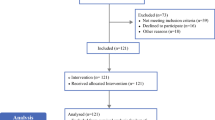Abstract.
In stage I cutaneous melanoma, biopsy of the first tumour-draining lymph node (sentinel node, SN) may replace routine elective lymph node dissection (ELND). The patent blue dye (PBD) technique has been shown to be an original method for the localization of the SN, but its sensitivity is sometimes unsatisfactory, depending on the basin where the SN is located. We compared three methods to locate the SN: intraoperative PBD mapping, lymphoscintigraphy (LS) with an aspecific tracer (colloid) and LS with a specific tracer (monoclonal antibody, MoAb). Fifty patients with cutaneous melanoma were enrolled in this study. The day before surgery LS was performed following an intradermal injection of 55 MBq technetium-99m-labelled HSA colloidal particles (25 patients: group A) or 220 MBq of 99mTc-F(ab’)2 MoAb 225.28 S (25 patients: group B) around the site of the primary lesion. In group B an equal amount of tracer was injected, as a control, in the contralateral site. Early and delayed images were acquired with a gamma camera and SN(s) marked on the skin. In all 50 patients the PBD technique was also performed immediately before surgery. When a blue node was identified intraoperatively, its radioactivity level was measured with a gamma probe. In the absence of blue coloration, the probe alone was used to detect the SN. Lymphoscintigraphic visualization of SNs was possible in 50/50 patients (100%), a total of 73 SNs (38 in group A and 35 in group B) were found, distributed in 55 basins. Gamma probe detection (GPD) allowed the identification of SNs in 49/50 patients (98%), and 72 SNs in 54 basins were localized. By contrast, using PBD, SNs were stained only in 40/50 patients (50 SNs in 40 basins). A tumour-positive SN was histologically proven in 13 patients (26%). In group B, no increase uptake was observed in the seven positive SNs (6/25 patients) compared with the contralateral uninvolved nodes. In conclusion this study demonstrates that LS combined with GPD is a safe method for detecting SNs and is more sensitive than the PBD technique. The use of MoAb fragments did not show any advantage over the non-specific tracer.
Similar content being viewed by others
Author information
Authors and Affiliations
Additional information
Received 3 July and in revised form 3 August 1998
Rights and permissions
About this article
Cite this article
Bartolomei, M., Testori, A., Chinol, M. et al. Sentinel node localization in cutaneous melanoma: lymphoscintigraphy with colloids and antibody fragments versus blue dye mapping. Eur J Nucl Med 25, 1489–1494 (1998). https://doi.org/10.1007/s002590050326
Issue Date:
DOI: https://doi.org/10.1007/s002590050326




